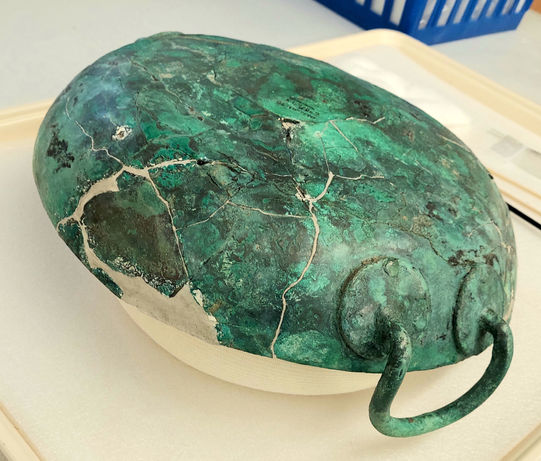Specialized in Object and Library & Archive Conservation

Wine Set
Report Summary
Treatment Images
Historical Context and Significance
This wine set (86-18-1590 through 86-18-1593) was such a pleasing find that it was chosen as the cover art for the book on the expedition. It is from the 13th Century BCE and was found on February 9th, 1964, in tomb 101 in a cemetery at the Tell Es-Sa’idiyeh archaeological site in Jordan. According to James Pritchard the metals have been worked with “skill and artistry” so the individual they were buried with may have been very wealthy or of high status. This set of objects (laver, wine bowl, strainer, and juglet) were used to serve wine. Similar arrangements of objects were found at Megiddo, Beth Shan, Tell el’Ajjul, and Tell el-Far’ah sites.
See full reports for citations and references.

Wine set drawing as a chapter heading in the site excavation publication by James Pritchard

Wine set in situ in Tomb 101
Condition and Description
Laver: 86-18-1590
A large shallow bowl with two curved handles. There are cracks throughout that are evidence of previous breaks that have been repaired. Green corrosion (like malachite) exhibited overall, likely from aging as well as the previous sodium sesquicarbonate treatments. There are areas of dark surface visible behind the green throughout. X-Ray shows small areas of fill material in the form of gaps, but most of the object is original material which is entirely corrosion product at this point and no longer copper metal alloy.
See the object on the Penn Museum's website.
Wine bowl: 86-18-1591
A round bowl. There are some cracks on the bottom of the bowl from previous breakages that have been repaired, as adhesive is visible in the cracks. Green corrosion (like malachite) exhibited overall, likely from aging as well as the previous sodium sesquicarbonate treatment. X-Ray shows a network of blind cracks that are also visible in naked light. No fills present. Object is entirely original material which is entirely corrosion product at this point and no longer copper metal alloy. No treatment deemed necessary at this time.
See the object on the Penn Museum's website.
Strainer: 86-18-1592
The strainer is composed of a small half sphere shaped bowl with a flared rim. The handle begins at a portion of the edge of the obtuse angle and turns downward to form a loop. The strainer is attached via corrosion to the Juglet (86-18-1593) in the set, obscuring the inside bowl surface. The looped handle is broken at the end of the loop and no longer reconnects to itself. Previous breaks throughout the object have been repaired. There are two losses on the bottom. Losses on the rim and handle have been filled and in painted previously. Green corrosion(probably malachite)overall likely from aging as well as theprevious sodium sesquicarbonate treatment. X-Ray shows small area of fill material at the edge, near a network of blind cracks. Most of the object is original material, which is entirely corrosion product at this point and no longer metal alloy. There is a thicker area in the overlap between this object and the juglet (86-18-1593) which may be where the two objects are corroded together.
See the object on the Penn Museum's website.
Juglet: 86-18-1593
A round bodied vessel with a thinner neck and spout. The mouth of the jug has a rounded rim. The handle comes directly out of the rim in a cylindrical shape, then twisted as described previously. The juglet is attached via corrosion to the strainer (86-18-1592) in the wine set, obscuring some of the object’s outer surface. Losses on the body and neck have been filled and inpainted. Green corrosion (probably malachite) exhibited overall likely from aging as well as the previous sodium sesquicarbonate treatment. X-Ray shows small area of fill material in the body, also visible to the naked eye. The fill in the neck is not visible potentially due to the overlap of layers below this fill. Most of the object is original material which is entirely corrosion product at this point and no longer copper metal alloy.
See the object on the Penn Museum's website.
Treatment Summary

Laver
Dissasembly:
Using an acetone solvent chamber I began disassembly. I continued to disassemble the piece using a scalpel and mechanical action.

Strainer
I removed the overpaint using acetone and the previous fill material using mechanical action. I inpainted the residual fill material using Golden Fluid Acrylics.

Laver
Re-assembly:
I used B-72 bulked with microballons to re-assemble the piece. Clamps and weights held the fragments in place while the adhesive set.

Strainer
I re-attached the handle with a butt join using 30% B-72. I then re-enforced the join with a layer of toned Japanese paper that I inpainted once dry.

Laver
Loss Compensation:
I used bulked B-72 to fill small losses and blotter paper saturated with 30% B-72 then laminated with bulked B-72 to fill larger losses.

Juglet
I removed the overpaint to reveal the fills. Removing and replacing the fills would cause more harm than good, so I simply re-did the overpaint.
Change in Condition: Strainer
The strainer unfortunately underwent a drastic change in condition while in the museum photo studio. The handle was completely detached. I re-attached the handle using Paraloid B-72 bulked with microballons and reinforced the join from underneath with Japanese paper. Then I inpainted the join and the Japanese paper with Golden fluid acrylics and fluid matte medium.








